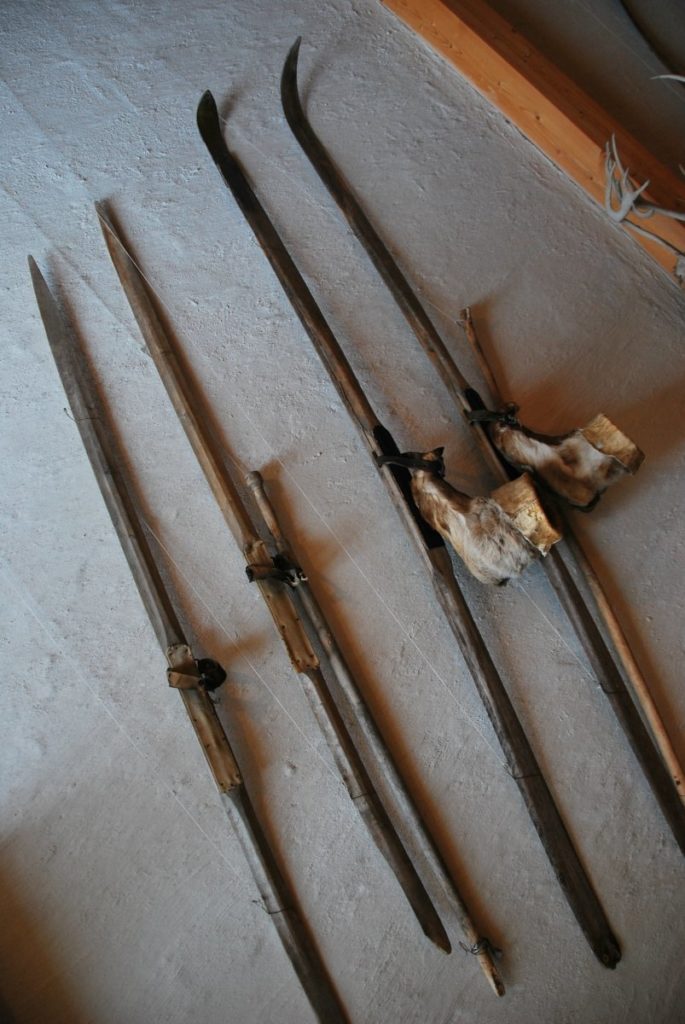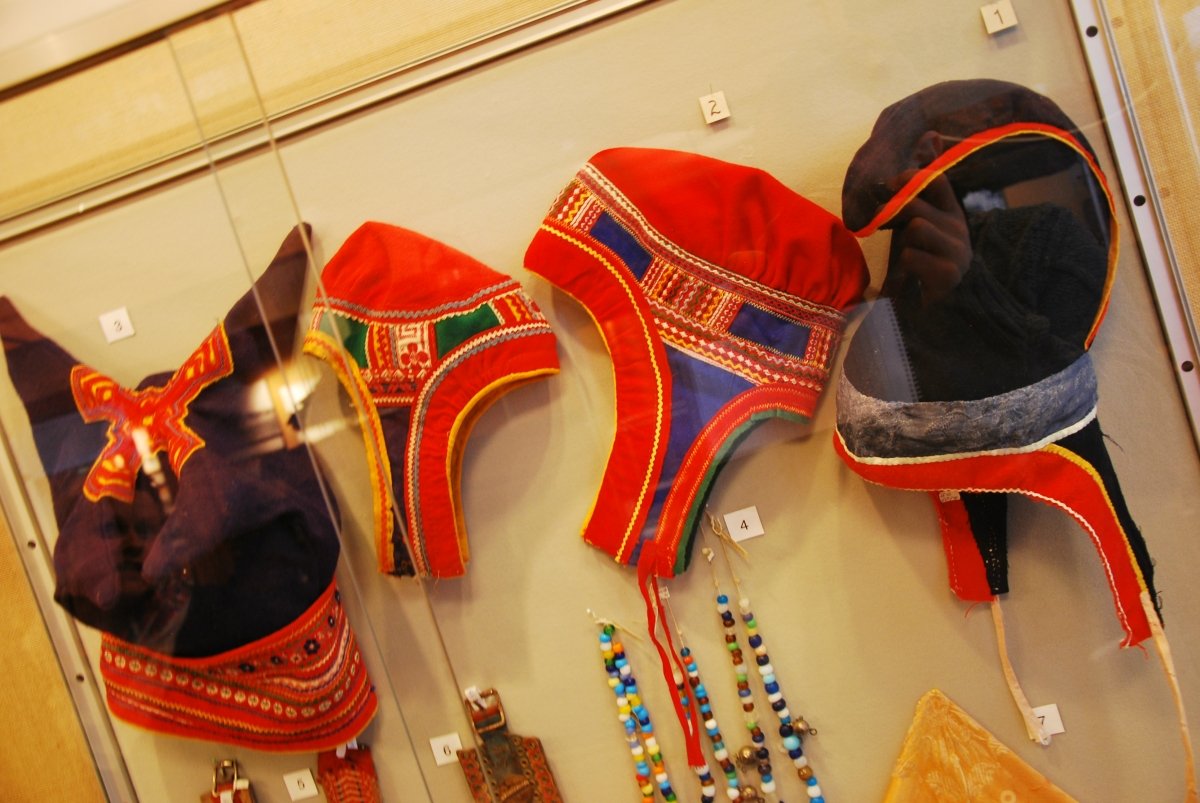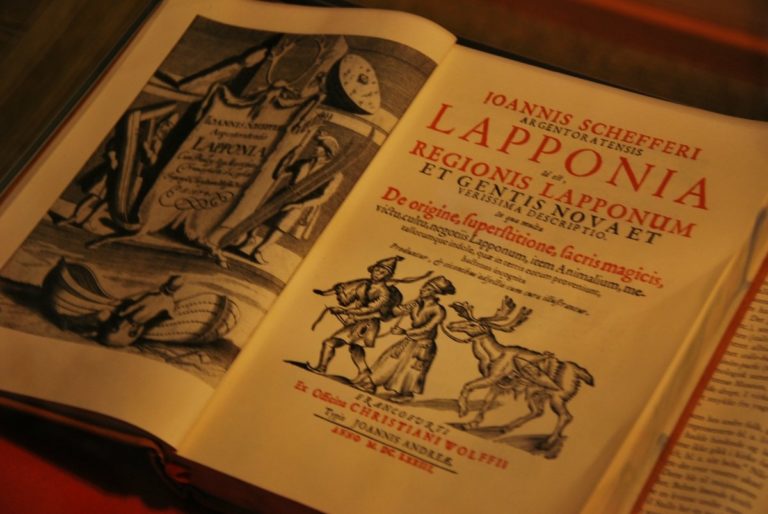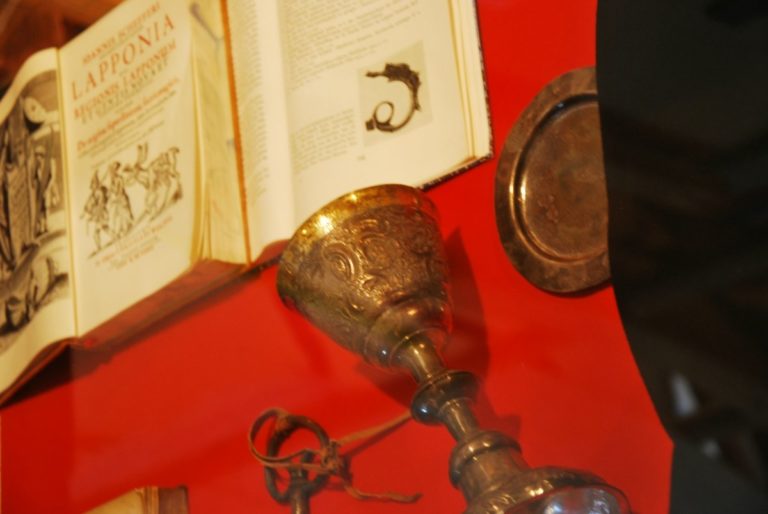Kautokeino local museum is packed full of interesting facts about this special village at the southern edge of the Finnmark plain. An impressive collection of costumes, a small collection of skis, and more than a few surprises from its rich history; you can learn more on a guided tour.
It’s worth studying a faded aerial photo of Kautokeino in 1930. A small number of large, wooden houses form the hotel and accommodation for the district nurse, parson and other civil servants. Everyone else lives in simple cabins and turf huts. Since there was no road, semi-domesticated reindeer were the means of transport for rich and poor, Sami and Norwegians alike. The Kautokeino residents built storehouses and cabins on their land for the Sami reindeer herders, where the herders could keep clothes and equipment that they didn’t need all the time. In return, the Sami reindeer herders tended the residents’ domesticated reindeer.
Wolf hunting was done on ski
A collection of old skis hangs on the wall. Some skis are long and wide, suitable for tending reindeer. Others are shorter and narrower, designed for hunting wolves. If you chased a wolf on fast skis, it eventually became exhausted and keeled over in the snow, after which you could easily shoot it. Wolves were a constant threat to the reindeer herds. The reindeer could smell the wolves, and drew closer to the tents. That was the time to light a campfire and sing loud and aggressive “joik” songs to keep the wolves away.
Practical information on Kautokeino local museum
Karasjok is located in central eastern Northern Norway close to the Finnish border. There is no airport in Karasjok, therefore it is recommended to fly to Lakselv to the north and take a bus or rent a car to make the journey. Karasjok is far from the ocean, therefore no boat routes will take you there.
Karasjokk is well inland, and therefore experiences a continental climate pattern. During the winter months it’s not uncommon for Karasjok to be the coldest place in all Norway with temperatures in January example averaging at -17, but having dropped below -45 degrees Celsius on occasion. In the Summer however, the temperature can rise into the high 20s and low 30s. Therefore it is up to you as to which extreme you wish to endure.
The museum has its own website with all the information you’ll need about visiting Kautokeino.
Tracked vehicles roamed the Finnmark plains from Alta to Kautokeino
Until 1964, there were no roads in Kautokeino that were open all year round, so the community was supplied with food by a tracked vehicle that came over the mountains from Alta via Masi. It travelled at 8 km/h (5 mph), and took between 5 and 7 days to make the journey. The tracked vehicle pulled several trailers behind it, like a small freight train. One of the trailers contained a stove that was never allowed to go out, so that the fresh produce didn’t freeze. Several drivers took turns to drive the vehicle, so there was a sleeping alcove at the back of the train. A model of this tracked vehicle is on display at the museum.
A Church site has existed since 1650
Kautokeino got its first church in 1650, built by the Swedes. This was replaced by a new church in 1701. In 1751, the border between Norway and Sweden–Finland was adjusted, and Kautokeino ended up on the Danish–Norwegian side, while their close relatives in Enontekiö ended up on the Swedish–Finnish side. This church was burnt down as part of the razing of Finnmark in 1944. However, the parson’s wife and a housekeeper had buried the chalice and the old keys to the church, and these are now on display at the museum, along with a series of pictures of the old church.

Traditional clothing
Many of the exhibitions are dedicated to the traditional clothing of Kautokeino. On their feet, people wore outer boots made from reindeer leg skins. These were stuffed with dried sennegrass, which traps layers of air and is an ideal insulator. White outer boots are used for special occasions, while everyday boots are the regular grey–brown colour. “Bellinger” leggings are trousers that are also made from reindeer leg skins. A “pesk” is used as outerwear for the upper body, and is an anorak-style jacket worn with the fur outside. Inside that, the Sami would wear a “dork”, which had fur inside.
There is a timeline of living costume traditions
There is no policy governing the national costumes worn in the Sami homelands; the “kofte” outfits are a costume tradition that is constantly evolving. You can’t show up at a confirmation wearing an outfit from the nineties these days — colours, colour combinations and patterns are always changing. However, each seamstress has her own style. The exhibitions have examples going back to the fifties, and you can see how the outfits have become more colourful and ornamental over the last few decades. The Kautokeino kofte is the most colourful of all the outfits in the Sami homelands.


